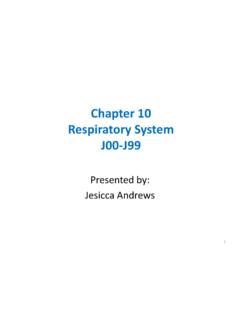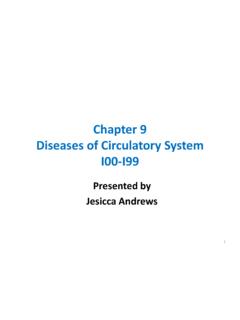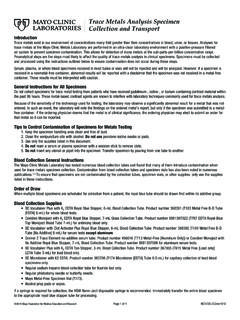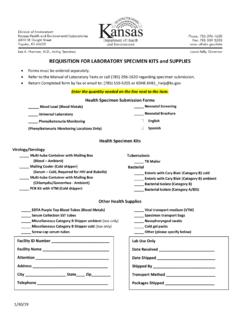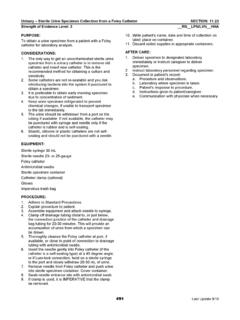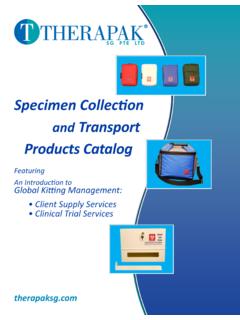Transcription of LABORATORY SERVICES PROVIDED BY COOLEY DICKINSON …
1 Clinical LABORATORY specimen collection Guide Page 1 of 98 Reviewed October 25, 2010 LABORATORY SERVICES PROVIDED BY COOLEY DICKINSON HOSPTIAL THE FOLLOWING DOCUMENT DESCRIBES THE LABORATORY SERVICES AVAILABLE THROUGH THE COOLEY DICKINSON HOSPITAL, BOTH STAT AND ON A ROUTINE BASIS, AS WELL AS INSTRUCTIONS FOR specimen LABELING AND HANDLING, VENOUS BLOOD collection , AS WELL URINE collection GUIDELINES. specimen LABELING AND HANDLING GUIDELINES Principle To ensure the quality of specimen collection , handling and labeling. Procedure Labeling Specimens and Containers All specimens MUST be labeled with the following information: Patient s last name, first name, and date of birth.
2 All information must be placed on a label which is on the container or directly on the container using a proper marking tool. Identifying information placed on covers of containers is NOT acceptable. Open Containers Specimens delivered to the LABORATORY in an open container such as a cup, pail, basin, rubber glove, open toilet paper, etc. are considered unacceptable. Outside Contamination of specimen Container The outside of containers or accompanying requisition slips should not be contaminated, ( contamination of a container with feces, urine, blood, etc.) If the specimen container is inadvertently contaminated at the time of collection and it is not feasible to collect a second specimen , the contaminated container should be placed inside a plastic bag and sealed, and this fact noted on the requisition slip.
3 Contaminated requisition slips should be discarded and a new one filled out. Damaged specimen Container Clinical LABORATORY specimen collection Guide Page 2 of 98 Reviewed October 25, 2010 Glass or plastic containers which are cracked or broken so that the specimen may leak out (or may be considered a hazard to those handling the object) should not be submitted for examination. If a second specimen cannot be easily obtained, the damaged container should be placed in a clean plastic bag and hand carried to the LABORATORY with an accompanying explanation to the LABORATORY worker.
4 Hemolyzed Blood Specimens As a general rule, hemolyzed blood is unsatisfactory. Each section of the LABORATORY must judge whether the hemolysis will affect the analysis in accordance with department guidelines. Delay in Transport of Specimens to the LABORATORY Specimens must be delivered promptly to the LABORATORY after collection . Delays can alter and often negate the desired result, urine that is allowed to remain at room temperature, cytology specimens not preserved, etc. specimen Handling Guidelines All specimens are refrigerated within an hour unless otherwise specified. See specimen Integrity Guidelines below.
5 Blood Cultures are kept at room temperature. All SST s and PST s are spun after 30 minutes of being collected unless otherwise specified. Then refrigerate. Red Tops are spun after 30 minutes of being collected and are then separated and put into a screw cap vial and labeled appropriately. Then refrigerate or freeze or keep at room temperature according to instructions. Pay close attention to special instructions such from light, freeze, etc. Purple/Lavender Tops (EDTA) and Light Blue Tops (Sodium Citrate) are not spun unless otherwise specified. These can be refrigerated immediately or follow the guidelines below if they cannot be refrigerated immediately.
6 Clinical LABORATORY specimen collection Guide Page 3 of 98 Reviewed October 25, 2010 Hematology/Coagulation specimen Integrity Guidelines CBC: 24 hours at room temperature 48 hours at 2 8 C RETICULOCYTE (RETA): 24 hours at room temperature 72 hours at 2 8 C ESR: 5 hours at room temperature 12 hours at 2 8 C PT: 24 hours at room temperature, spun or unspun APTT: Routine non-heparinized patient 4 hours at room temperature or at 2 8 C Clinical LABORATORY specimen collection Guide Page 4 of 98 Reviewed October 25, 2010 VENOUS BLOOD collection PROCEDURE 1.
7 Principle To obtain a blood specimen from the patient for LABORATORY analysis. 2. Procedure Equipment: i. Gloves ii. Tourniquet iii. Alcohol wipes (soap/water if drawing for Alcohol) iv. Gauze v. BD Eclipse needle NOTE: (NOT PREASSEMBLED) (Preassembling needles to needle holders is NOT permitted. It is a sharps hazard. Also, you should be breaking the seal on the needle in front of the patient). vi. Needle holder vii. Blood collection tubes viii. Bandage ix. Biohazard sharps container b. If a patient has a latex allergy, refer to policy for Latex Allergic Patient.
8 C. Identify the patient. See Patient Identification Policy. Address the patient as Miss, Mrs., or Mr. unless otherwise instructed by the patient. d. Introduce yourself and explain the procedure to the patient. e. Verify patient diet restrictions (fasting). f. Properly position the patient. Gloves must be worn from the point where there is potential for exposure to a body fluid. g. Verify preprinted labels are present for all tests ordered and that the patient information on the labels is correct. Clinical LABORATORY specimen collection Guide Page 5 of 98 Reviewed October 25, 2010 h.
9 Select the appropriate blood collection supplies and establish the order of draw: i. Blood cultures ii. Coagulation tubes ( sodium citrate/light blue top) iii. Serum separator tubes with or without clot activator, with or without gel ( red top, gold top, red/black speckled top) iv. Heparin tubes with or without gel plasma separator ( green top) v. EDTA tubes ( purple or lavender tops) vi. Glycolytic inhibitor ( gray top) vii. Any other tubes i. Reassure the patient that although the venipuncture may be slightly painful, it will not last long. Position the patient with the elbow extended and the arm supported.
10 Have the patient make a fist, but avoid vigorous hand exercise (pumping). j. Apply the tourniquet about 3-4 inches above the venipuncture site. Do not stop the blood flow for more than one minute before the blood is drawn. If necessary, release and reapply the tourniquet. k. Select the venipuncture site by palpating for a vein. The median antecubital and cephalic veins are most commonly used. If either one of these veins is unable to be successfully punctured, the third choice is the basilic vein. The basilic vein should only be used as a last resort and you should be cautious when puncturing this area, as excessive probing to this area is extremely dangerous.


